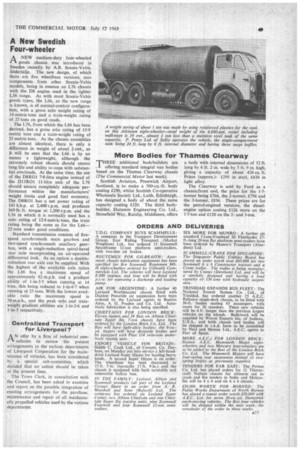A New Swedish Four-wheeler
Page 51

If you've noticed an error in this article please click here to report it so we can fix it.
1-1 A NEW medium-duty four-wheeled goods chassis was introduced in Sweden recently by A_13. Scania-Vabis, SOdertalje. The new design, of which there are five wheelbase versions, uses components from other Scania-Vabis models, being in essence an L76 chassis with the D8 engine used in the lighter L56 range. As with most Scania-Vabis goods types, the L66, as the new range is known, is of normal-control configuration, with a gross solo weight rating of 14 metric tons and a train-weight rating of 25 tons on good roads.
The L76, from which the L66 has been derived, has a gross solo rating of 15.9 metric tons and a train-weight rating of 35 metric tons. As the chassis assemblies are almost identical, there is only a difference in weight of about 2 cwt., so it will be seen that the L66 is by no means a lightweight, although the extremely robust chassis should ensure long life and ability to cope with substantial overloads. At the same time, the use of the D8R01 7.8-litre engine instead of the D11R01 11-litre unit of the L76 should ensure completely adequate performance within the manufacturers' weight limits and good fuel economy. The D8R01 has a net power rating of 143 b.h.p. at 2,400 r.p.m. and produces 369 lb. ft. torque at 1,200 r.p.m. and the L56 in which it is normally used has a solo rating of 12-6 metric tons, the train rating being the same as for the L6625 tons under good conditions.
Standard transmission consists of fivespeed synchromesh main gearbox and two-speed synchromesh auxiliary gearbox, with a single-reduction spiral-bevel rear axle incorporating an air-operated differential lock. As an option a doublereduction rear axle can be supplied. With the highest of the available axle ratios the L66 has a maximum speed of approximately 62 m.p.h. and a gradient ability of 1-in-3-5 when running at 14 tons, this being reduced to 1-in-6-7 when running at 25 tons. With the lowest available ratio the maximum speed is 50 m.p.h., and the peak solo and trainweight gradient abilities are I-in-2.6 and 1-in-5 respectively.




















































































































